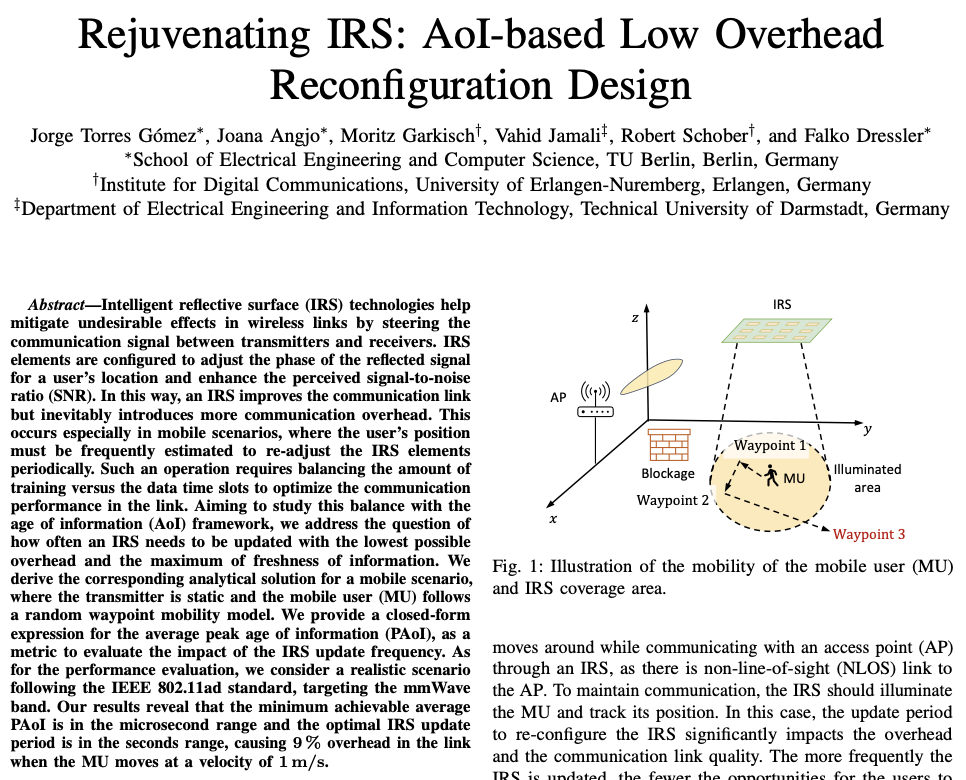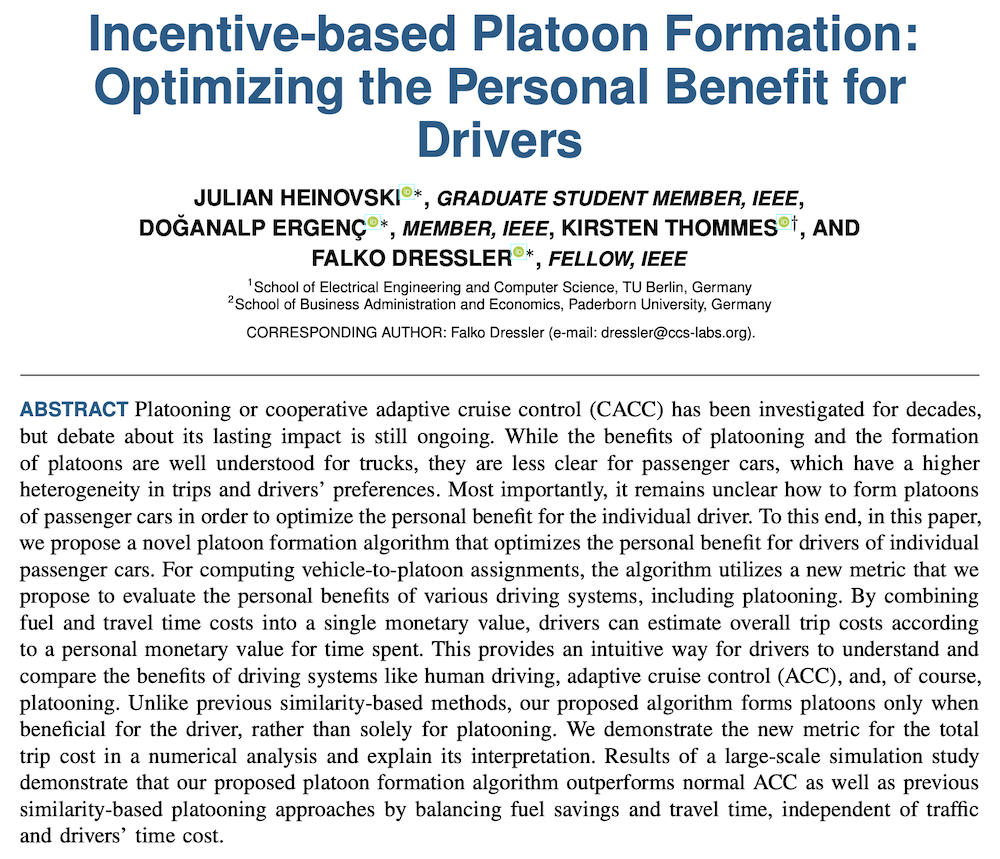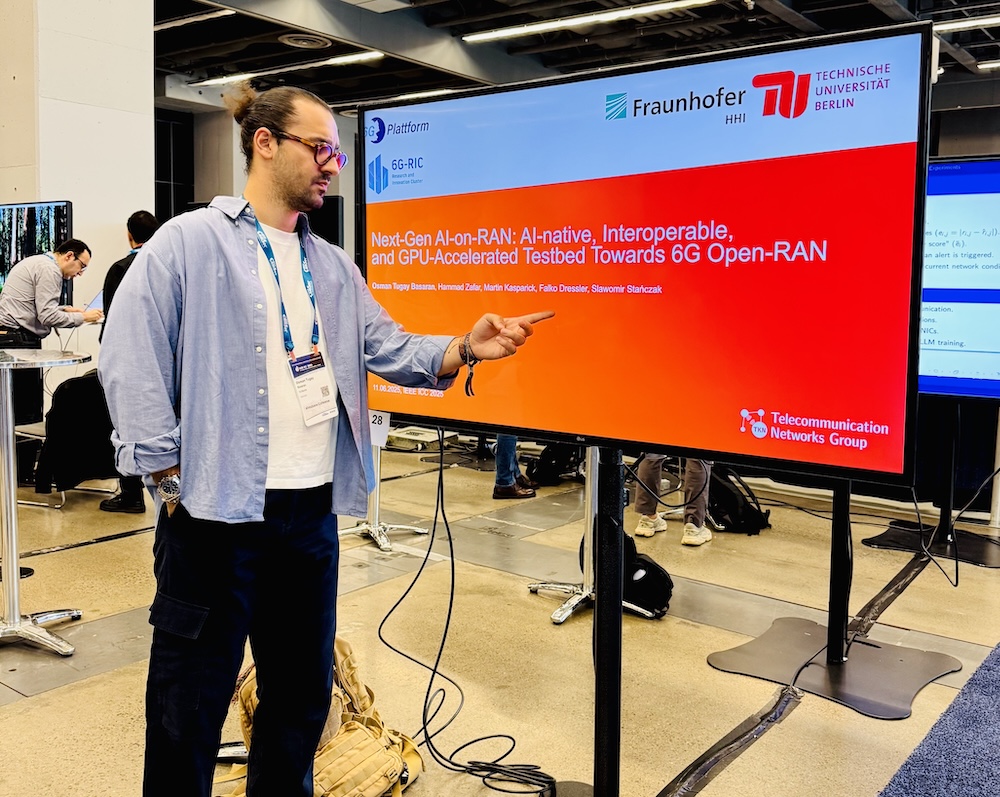Literature Database Entry
keshavamurthy2024sidelink
Prajwal Makkimane Keshavamurthy, "Sidelink Radio Resource Management for Vehicular Communications in Co-Operative Automated Driving," PhD Thesis, Fachbereich Elektrotechnik/Informatik, Univeristät Kassel, August 2024. (Advisor: Dirk Dahlhaus; Referees: Dirk Dahlhaus and Falko Dressler)
Abstract
Automated driving is emerging as a key trend and presents an opportunity for coordination among autonomous vehicles to improve road traffic flow, fuel efficiency and safety. In this regard, co-operative automated driving (CAD) is a means for vehicles to perform co-operative trajectory planning and enhance environment perception by leveraging their vehicle-to-vehicle (V2V) communication capabilities via co-located vehicle user-equipment (V-UE). Typical examples of CAD include platooning, cooperative lane change (CLC) and co-operative collision avoidance (CCA). The quality of service (QoS) requirements for CAD V2V communications span a wide range with a reliability of 90-99.999 % and an end-to-end packet delay of 3-100 ms. Here, the flexibility of QoS requirements reflects the performance tolerance depending on the use cases and different levels of automation (LoA) at the expense of suboptimal operations. Sidelink (direct V2V link) radio resource management (RRM) plays a key role in meeting the CAD QoS requirements with QoS-aware radio resource scheduling (RRS). This requires tight interaction between CAD applications and the sidelink RRM. In addition, CAD necessitates V2V interactions and interference coordination among V-UEs across mobile network operators (MNOs), and vertical partners (e.g., automotive organizations) may wish to control sidelink radio resources. Therefore, the sidelink RRM needs to be abstracted or decoupled from the operator’s network. To this end, the sidelink RRM functionality is moved to operator-independent cloud-based network entities that can be accessed by V-UEs across MNOs. A cloud-enabled sidelink RRM framework is introduced which allows for placement of sidelink RRM functionality in a logically centralized cloud entity in a multi-operator environment. By capturing the diverse QoS requirements of CAD multicast group communication using utility functions, a QoS-dependent utility-based multi-objective radio resource allocation optimization problem, which aims to maximize the aggregated utility, is described, wherein the resources refer to resource blocks (RBs) and modulation and coding schemes (MCSs). Moreover, a low-complexity heuristic centralized RRS solution is proposed and analyzed for cloud-based sidelink RRM with potentially high vehicle-to-network (V2N) link delay and a dynamic vehicular environment. Accounting for the challenges in acquiring channel state information (CSI), the dynamic RRS solution is enhanced to make use of slowly varying large-scale channel parameters (e.g. path loss) referred to as slow CSI. An edge-cloud enabled semi-centralized sidelink RRM framework is proposed to bring the dynamic scheduler closer to the V-UEs by leveraging the vehicular edge computing (VEC) capabilities of the autonomous vehicles. To exploit the benefits of the framework, the resource allocation problem is split into three tasks with high modularity and tunability. These tasks comprise a V-UE-cluster formation, an inter-cluster RB-pool allocation and an intra-cluster resource allocation allowing for optimized sidelink resource scheduling, which may be performed on different time scales at different cloud entities (central and edge) with reduced dynamic scheduling delay. A graph-theoretic approach is presented with 1) a CAD vehicle group clustering as a clique partitioning problem (CPP), which enables the coordination at the control plane between transmitting vehicles to avoid the hidden terminal problem and the limitations imposed by the half-duplex constraint, and 2) a cluster-to-RB-pool allocation as a max-min fairness problem on a weighted resource-conflict graph, which tackles the trade-off between enhancing spectrum utilization by efficient reuse of sidelink resources among clusters and limiting the inter-cluster interference to an acceptable level. In addition, a simple low-complexity intra-cluster resource allocation solution is presented. Simulation results in a realistic vehicular deployment in a fifth generation mobile networks (5G)-based simulation set-up show the ability of the proposed schemes to effectively adapt to different CAD requirements. Even in case of high V2N link delay, the slow CSI-based central RRS provides high V2V link quality in meeting the stringent reliability requirements. This, however, comes at the expense of resource utilization and hence the packet delay performance on V2V links. Yet, a semi-centralized scheme shows significant gains in terms of packet delay while maintaining a high V2V link quality.
Quick access
Contact
Prajwal Makkimane Keshavamurthy
BibTeX reference
@phdthesis{keshavamurthy2024sidelink,
author = {Keshavamurthy, Prajwal Makkimane},
title = {{Sidelink Radio Resource Management for Vehicular Communications in Co-Operative Automated Driving}},
advisor = {Dahlhaus, Dirk},
institution = {Fachbereich Elektrotechnik/Informatik},
location = {Kassel, Germany},
month = {8},
referee = {Dahlhaus, Dirk and Dressler, Falko},
school = {Univerist{\"{a}}t Kassel},
type = {PhD Thesis},
year = {2024},
}
Copyright notice
Links to final or draft versions of papers are presented here to ensure timely dissemination of scholarly and technical work. Copyright and all rights therein are retained by authors or by other copyright holders. All persons copying this information are expected to adhere to the terms and constraints invoked by each author's copyright. In most cases, these works may not be reposted or distributed for commercial purposes without the explicit permission of the copyright holder.
The following applies to all papers listed above that have IEEE copyrights: Personal use of this material is permitted. However, permission to reprint/republish this material for advertising or promotional purposes or for creating new collective works for resale or redistribution to servers or lists, or to reuse any copyrighted component of this work in other works must be obtained from the IEEE.
The following applies to all papers listed above that are in submission to IEEE conference/workshop proceedings or journals: This work has been submitted to the IEEE for possible publication. Copyright may be transferred without notice, after which this version may no longer be accessible.
The following applies to all papers listed above that have ACM copyrights: ACM COPYRIGHT NOTICE. Permission to make digital or hard copies of part or all of this work for personal or classroom use is granted without fee provided that copies are not made or distributed for profit or commercial advantage and that copies bear this notice and the full citation on the first page. Copyrights for components of this work owned by others than ACM must be honored. Abstracting with credit is permitted. To copy otherwise, to republish, to post on servers, or to redistribute to lists, requires prior specific permission and/or a fee. Request permissions from Publications Dept., ACM, Inc., fax +1 (212) 869-0481, or permissions@acm.org.
The following applies to all SpringerLink papers listed above that have Springer Science+Business Media copyrights: The original publication is available at www.springerlink.com.
This page was automatically generated using BibDB and bib2web.






